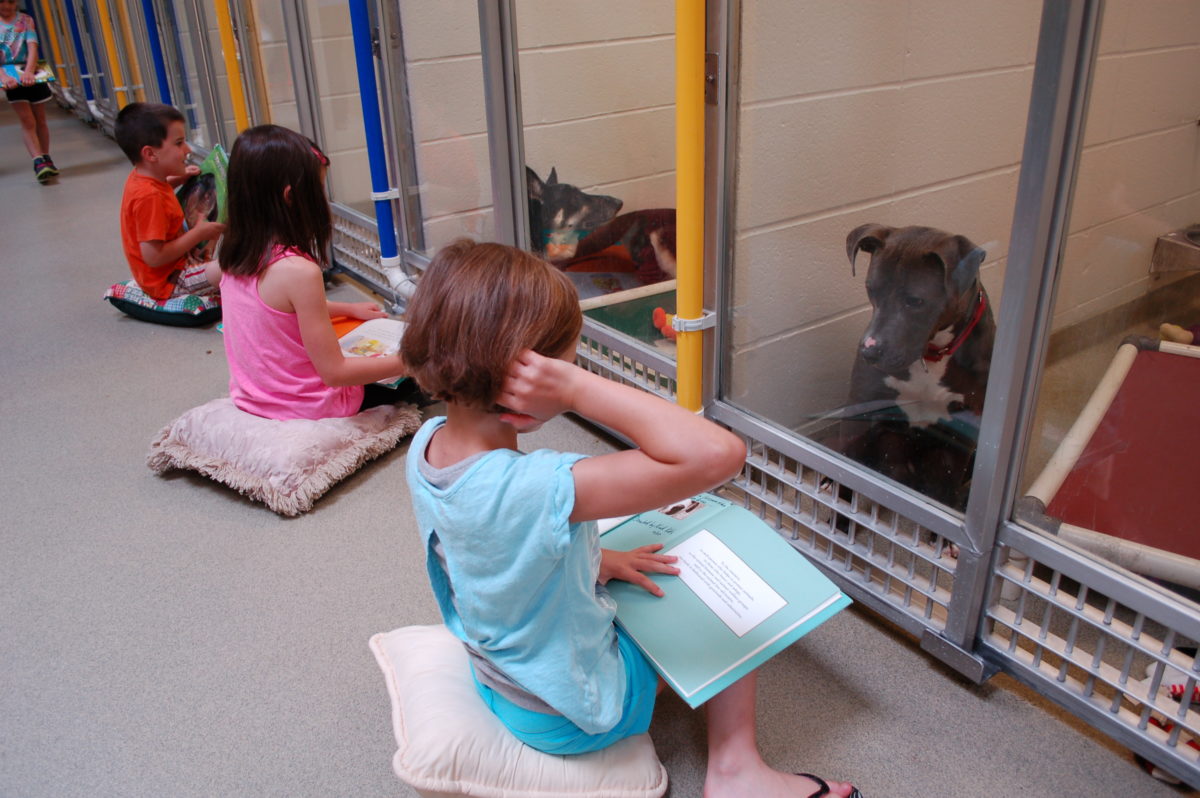Who doesn’t love being told a story? Dogs and cats are no different. Here’s how shelter reading plans can improve pets’ chances of adoption.
Imagine you are housed in a shelter, suffering loud noises from other anxious animals and smelling scents that definitely aren’t from a home. You enjoy little social interaction and are confined to a small space. Then imagine a caring person sitting in front of you and reading to you—and you alone—in a quiet, calm voice. Would it go a long way toward erasing some of the stress of your daily environment? Maybe even influence your temperament and help you find a new permanent home?
It’s well documented that reading to young children helps calm them when they are restless, instills a greater sense of wellbeing, and enhances bonding between reader and child. Shelter dogs enjoy many of those same positive benefits when human volunteers read to them or when audiobooks are played in a kennel environment.
A recent study published in Applied Animal Behaviour Science investigated the effects of listening to audiobooks on the behavior of 31 dogs housed in a rescue shelter. The dogs were exposed to audiobooks, classical music, pop music, psychoacoustically designed dog music, and no auditory controls for two hours, with two days between sessions. Researchers found that dogs who listened to audiobooks spent more of their time resting and less time displaying vigilant sitting or standing behavior than when exposed to all other auditory conditions.
Tale of two shelters
Many shy, scared, and restless shelter animals respond positively when read to. To build on that benefit, some animal shelters have instituted programs designed for kids who want to help homeless pets—simply by sharing the same reading experience they themselves love.
Two such shelters, the Humane Society of Missouri in St. Louis and the Stephens County Humane Society in Duncan, Oklahoma, say their Shelter Buddies Reading Program calms stressed dogs and helps them get adopted sooner.
During volunteer training at the Humane Society of Missouri, kids ages 5 to 15 learn about canine body language and how to approach the dogs’ kennels in a nonthreatening manner. During training, kids walk through kennel areas to gain an awareness of what the dogs likely are experiencing. Finally, the kids learn to use calm, low voices while reading to and talking around the dogs. Then they are ready to sit outside the kennels and read.
Does it make a difference?
Definitely, says JoEllyn Klepacki, director of education for the Humane Society of Missouri, which houses 8,000 to 10,000 dogs annually.
“The impact is so amazing,” she says. “More often than not, the animals respond favorably to a child by the time one picture book is read. [The dogs] absolutely learn quickly and become conditioned to approach the kennel front to greet visitors. Time and again we have witnessed frightened, timid, and reclusive dogs and cats cautiously approach the children; once they feel safe and secure, they get as close as they can to the children and eagerly accept their attention and gentle words of praise and reassurance.”
Gradually, reactive dogs calm down and visibly relax as a child sits, reading without reacting to the dogs, Klepacki says.
“We truly have seen a transformative effect on our animals, especially those who initially display fear and anxiety,” she says. “We have even had animals who have shown such improvement that they no longer need dog-appeasing pheromone collars or Thundershirts to calm them.”
At Stephens County Humane Society, which houses about 55 dogs and 35 cats at any one time, a parent or adult must accompany a child, sessions last one hour, and about 20 children participate per session, says Patti Whitaker, a representative of the humane society’s board of directors. Each child is encouraged to bring dog or cat treats to give to the shelter pet while reading.
Using “library voices,” children sit quietly in front of a kennel, give the animal a treat and immediately open their book. They read softly and show a book’s pictures to their shelter pet.
“It is amazing to see this process,” Whitaker says. “When we first walk into the kennel room, of course the dogs are all barking and excited, but as the process begins, the dogs calm down and become quiet, their attention on the reader. Some of the dogs have even fallen asleep. The dogs are absolutely calmer when the session ends. It is precious.”
Reading delivers results
HSMO has reduced its average length of stay for shelter dogs from 14 to eight days to six days, Klepacki says.
“I think the greatest benefit to [the dogs] is that they are regularly experiencing positive interactions with caring people who provide companionship and comfort,” she says. “This reconditions them to approach the kennel front. The companionship and positive interactions help alleviate some of the stress they experience in a shelter environment. And ultimately, animals who approach potential adopters at the kennel front are adopted more quickly than those who don’t.”
The Stephens County Humane Society also believes its program helps its shelter pets learn vital social skills that can help them get adopted.
“As you can imagine, a lot of our animals have been neglected and abused,” says Whitaker. “This program helps the animals learn that not all people are bad. We have seen some dogs who are so frightened and stay in the back corner of their kennel actually come forward after a few minutes of the child reading and interacting with the animal.
“It’s a win-win,” she added. “The kids are readying the dogs and cats for forever homes by socializing with them, and the kids do not feel judged while reading.”
This article was reviewed/edited by board-certified veterinary behaviorist Dr. Kenneth Martin and/or veterinary technician specialist in behavior Debbie Martin, LVT.








